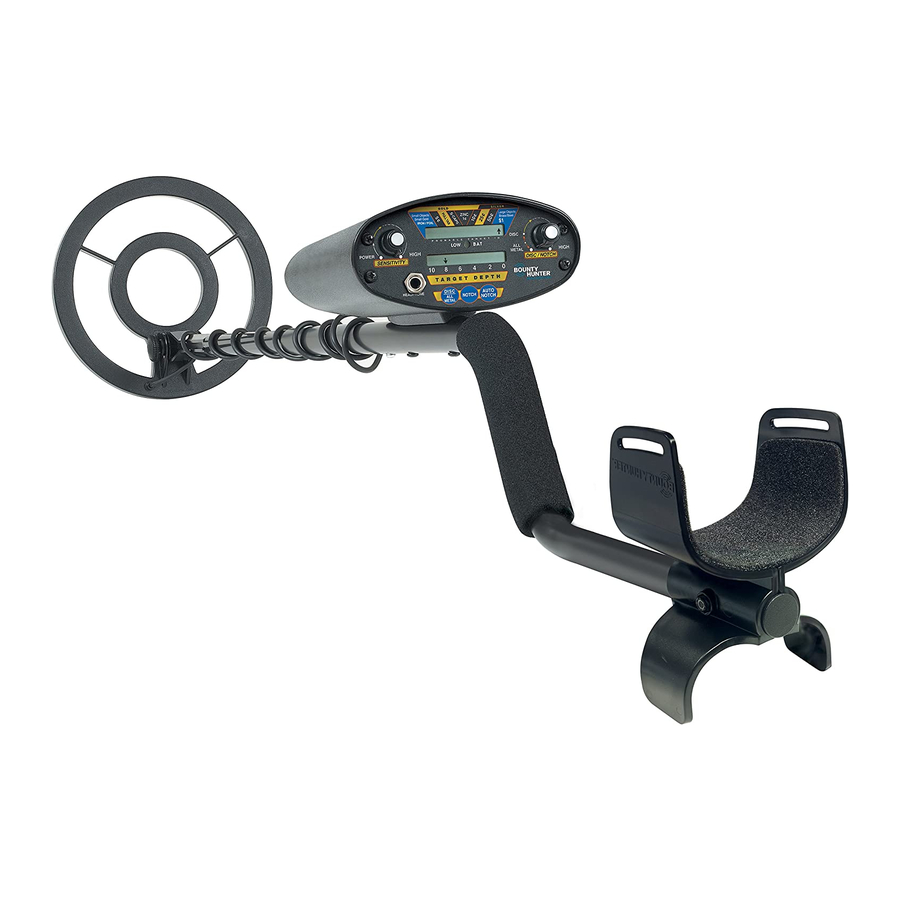Table of Contents
Advertisement
Quick Links
Download this manual
See also:
Owner's Manual
ACCESSORIES
Carry Bag
Rugged double-stitched construction – CBAG-W
Pouch & Digger Combo
Pouch with 2 large pockets & 9" heavy duty digging tool. – TP-KIT-W
Stereo Headphones
Use with Bounty Hunter metal detectors. Lightweight and adjustable with
true stereo sound, adjustable volume, 1/8 jack with 1/4 adaptor,
4' cable. – HEAD-W
Pin Pointer
Pinpoints the exact location of buried metal objects. Audio signal indicator
and vibrator. Runs on 1 – 9-Volt Battery. – PIN POINTER-W
Bounty Hunter
Sand Scoop
®
Large scoop with filtering holes. Made of strong plastic. – SAND SCOOPBH
Coil Covers
Protect your coil from abrasion and damage.
10" Coil Cover – 10COVER
8" Coil Cover – 8COVER-N
4" Coil Cover – 4COVER
Replacement/Accessory Searchcoils
10" Magnum Coil – 10COIL
8" Replacement Standard Coil – 8COIL-N
4" Gold Nugget Coil – 4COIL
9" Heavy-Duty Digging Tool
Metal blade with comfortable plastic handle and depth gauge – TROWEL-2
Digging Tool
Light and practical wide blade digging tool. – TROWEL-W
Bounty Hunter
T-Shirt
®
100% cotton with Bounty Hunter
®
Logo.
Sizes: S, M, LG, XL & XXL – BHTSHIRT
Bounty Hunter
Baseball Cap
®
®
One size fits all, with Bounty Hunter
logo. – BHCAP
Gold
Prospecting Kits
FOR COMPLETE DETAILS VISIT WWW.DETECTING.COM • 1-800-413-4131
MQD2
REV.3
Your Quick Draw
controlled technology. The Quick Draw
an object is required in order for the machine to detect the object and emit a
tone. Alternatively, you can sweep a metal object over a motionless searchcoil.
THIS METAL DETECTOR HAS TWO TYPES OF OPERATING MODES:
1. ALL METAL DETECTION
All metals will be detected.
2. DISCRIMINATE, NOTCH, and AUTO NOTCH Modes
In any of these three detection modes, the detector will emit different
tones, depending upon the type of metal present. The characteristics are
adjustable. Depending on the detector control settings, some metals will
also be eliminated from detection.
DISCRIMINATE:
NOTCH:
AUTO NOTCH:
CAUTION:
• Do not test the detector by placing coins or metal objects on the floor.
Most floors contain metal, which will cause interference.
• Use 9-VOLT ALKALINE batteries only.
• Operating Frequency: 6.5 kHz
DO NOT USE INDOORS. LIGHTS AND HOUSEHOLD APPLIANCES EMIT
ELECTROMAGNETIC FIELDS WHICH INTERFERE WITH THE DETECTOR'S
051414
OWNER'S MANUAL
®
II Metal Detector incorporates patented microprocessor-
®
II is a motion detector; movement over
Eliminates iron and trash items with the use of the
DISC/NOTCH knob.
Provides an adjustable rejection "window" to eliminate undesirable
metals from detection. Move the rejection "window" with the
DISC/NOTCH knob.
Provides a pre-set rejection "window", automatically eliminating
most pull-tabs and trash items from detection.
OPERATION
Advertisement
Table of Contents

Summary of Contents for Bounty Hunter Quick Draw II
- Page 1 Pouch & Digger Combo Pouch with 2 large pockets & 9” heavy duty digging tool. – TP-KIT-W Stereo Headphones Use with Bounty Hunter metal detectors. Lightweight and adjustable with true stereo sound, adjustable volume, 1/8 jack with 1/4 adaptor, 4’ cable. – HEAD-W Pin Pointer Pinpoints the exact location of buried metal objects.
-
Page 2: Product View And Features
We have Published by First Texas Products, L.L.C. Bounty Hunter ® is a registered trademark of First Texas Products, L.L.C. therefore incorporated special features into www.detecting.com... -
Page 3: Table Of Contents
CARE AND MAINTENANCE TABLE OF CONTENTS Your Quick Draw II Metal Detector is an example of superior design and ® ASSEMBLY ......... . .4 craftsmanship. -
Page 4: Assembly
TROUBLESHOOTING EASY ASSEMBLY Assembling your Quick Draw ® II Metal Knurled Bolt TROUBLESHOOTING GUIDE Knob Detector is easy and requires no tools. Just follow these steps: SYMPTOM CAUSE SOLUTION Using the supplied bolt and knurled knob, attach the searchcoil to the Detector chatters •... -
Page 5: Installing Batteries
METAL DETECTING APPLICATIONS BATTERIES COINSHOOTING: IMPORTANT: Always use ALKALINE batteries for optimal performance. The most popular metal detecting application. When coinshooting, you Always remove the batteries for prolonged storage. want to discriminate out pull tabs, screw caps, and iron objects. Beware that highly oxidized steel may also be detected. -
Page 6: Ii Demonstration
Quick Draw ® II DEMONSTRATION IN THE FIELD TECHNIQUES Here is a quick way to demonstrate the basic features of your Quick Draw After selecting your operating mode, objects. These signals are easily ® swing the searchcoil gently side-to- recognized by their often broken or I. -
Page 7: Basic Operation
IN THE FIELD TECHNIQUES BASIC OPERATION TURNING ON YOUR DETECTOR PINPOINTING COIL MOVEMENT Turn the left knob (SENSITIVITY) to the right. As the knob clicks to the "On" position, the detector sounds three beeps, the LCD arrows appear Accurate pinpointing takes practice When swinging the coil, be momentarily, and the unit pre-sets to the DISC/ALL METAL Mode of operation. -
Page 8: Reading The Display
LCD TARGET DISPLAY AUDIO TARGET-ID READING THE DISPLAY IRON/FOIL: All sizes of iron and Depending on the operating mode PULL-TABS: aluminum objects will register on the The Liquid Crystal Display (LCD) shows and Disc/Notch control setting, the Pull tabs are the most bothersome far-left side of the scale. -
Page 9: Low Battery Indicator
MODES OF OPERATION BATTERY & DEPTH INDICATORS The LOW BATT indicator will flash as suspected target and pause briefly at the metallic spectrum, but still detect AUTO NOTCH MODE the unit is powered on. If the indicator the end of each sweep to read your items to the left of the scale, as comes on and stays on, replace the display. -
Page 10: Sensitivity Adjustment
SENSITIVITY ADJUSTMENT MODES OF OPERATION ALL METAL MODE: clockwise, you will progressively “discriminate out,” or eliminate P R E S S F O R T A R G E T M O D E from detection, different types of metals. Refer to the illustration below as a reference for the levels required to discriminate out different objects.

















Need help?
Do you have a question about the Quick Draw II and is the answer not in the manual?
Questions and answers